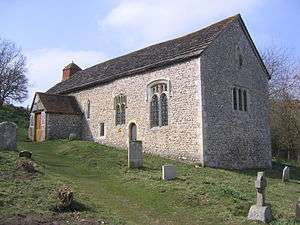Horsham Stone
Horsham Stone is a type of calcerous, flaggy sandstone containing millions of minute sand grains and occurring naturally in the Wealden clay of the English county of West Sussex.[1][2] It is also high in mica and quartz. The rock extends in an arc-like formation for several kilometres around the town of Horsham from which it takes its name, and lies just below the Wealden clay surface in bands 4 to 5 inches (10 to 13 cm) thick.[2] Horsham Stone is famous for its ripple-marked appearance, formed by the action of the sea similar to the ripples on the sandbanks and beaches of Sussex.

Formation
Sussex Stone and its limestone equivalent Sussex Marble were formed around 130 million years ago in the Lower Cretaceous period when Britain was quite different from the shape it is today. It is estimated that the latitude for Britain was approximately 30 degrees north of the equator.[1] The fossil evidence in Horsham Stone and Sussex Marble indicate a diversity of life living on a broad, flat subtropical landscape.Towards the end of the Cretaceous period around 90 million years ago, most of Britain including Sussex would have been submerged beneath a tropical sea that was depositing chalk.
The sediments of the Wealden Basin were buried under hundreds of metres of further sediment over the next 100 million years and were then uplifted gradually by platetonic movement and then eroded to expose Wealden rocks. Horsham Stone would have been visible to early settlers after the Ice Age around 12,000 years ago. When quarried, Horsham Stone could be extracted in "flat grey slabs of varying thickness".[2]
Uses of Horsham Stone

Horsham Stone has a long history of use. The earliest record is from the Bronze Age. Archeologists at Amberley found quern fragments made of Horsham Stone at Amberley Mount.[1] It was used extensively by the Romans including in the construction of Stane Street. Villas such as Bignor and Fishbourne have examples of flooring and roof slates of the material.
In later centuries, and there are numerous examples in Sussex and the surrounding counties of its use as a roofing material, particularly for mills, dovecotes, churches, manor houses and similar buildings. Completely rainproof and long-lasting, it was ideal for these structures.[2] Smaller-scale uses include road surfaces, for which the thickest slabs were typically used;[2] the footpaths leading to St Mary's Church, Shipley, West Sussex and the north wall of St Nicholas' Church, Itchingfield, West Sussex; and for gravestones, fonts and tombs (of which there are several examples at St Mary the Virgin's Church, Horsham).[1] Once exposed it hardens quickly and will last for hundreds of years. The characteristic ripple marks are retained. There are numerous old quarry workings throughout Sussex but just one working quarry in 2009. Large quarries at Nuthurst and Stammerham (near Christ's Hospital) school are no longer extant, but others survive in isolated Wealden settings.[2]
Commercial use in the early 21st century
Large-scale commercial extraction of Horsham stone had stopped by the 1880s,[4] and regular quarrying ceased completely in the 1930s with the closure of a small quarry at Nowhurst, Strood Green near Horsham. Purbeck Stone was regarded as a good substitute for Horsham Stone and repairs to stonework tended to substitute it for the more expensive and scarcer Horsham Stone. The Nowhurst quarry was reopened in 2004 by the Historic Horsham Stone Company. It has started producing roofing slates for the area's historic houses.
References
- 1 2 3 4 Sussex Stone, The Story of Horsham Stone and Sussex Marble, Roger Birch, 2006, ISBN 978-0-9551259-0-4
- 1 2 3 4 5 6 Brandon, Peter (2003). The Kent & Sussex Weald. Chichester: Phillimore & Co. Ltd. p. 31. ISBN 1-86077-241-2.
- ↑ Pé, Diana (2006). Mid Sussex Church Walks. PP (Pé Publishing). p. 46. ISBN 0-9543690-2-5.
- ↑ Brandon, Peter (2003). The Kent & Sussex Weald. Chichester: Phillimore & Co. Ltd. p. 32. ISBN 1-86077-241-2.